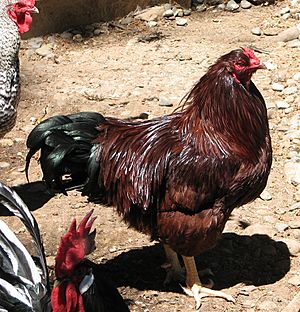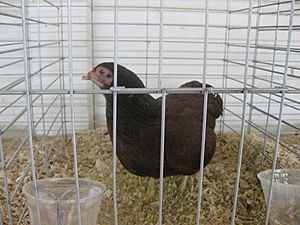Buckeye chicken facts for kids

A Buckeye rooster in British Columbia
|
|
| Conservation status | watch |
|---|---|
| Country of origin | United States |
| Traits | |
| Weight |
|
| Skin color | Yellow |
| Egg color | Brown |
| Comb type | Pea |
| Classification | |
| APA | American |
| PCGB | Rare soft feather: heavy |
|
|
The Buckeye is a special breed of chicken. It first came from the U.S. state of Ohio. This chicken breed was created in the early 1900s. It is the only standard chicken breed recognized by the American Poultry Association (APA) that a woman developed.
Buckeyes are also the only breed in the American Class with a pea comb. This means their comb is flat and close to their head. The breed's name comes from Ohio's nickname, "Buckeye state." Their rich mahogany color looks like the seeds of the Ohio Buckeye plant. These chickens are "dual-purpose." This means they are good for both laying eggs and for meat. Buckeyes have yellow skin and lay brown eggs. The Livestock Conservancy lists them as "Watch," meaning they are a rare breed.
Contents
The Buckeye Chicken's Story
How the Breed Started
The Buckeye chicken was first bred in 1896. A woman named Nettie Metcalf from Warren, Ohio, created them. She is the only woman known to have developed an American chicken breed. This is interesting because women often cared for chickens on farms.
Metcalf mixed different chicken breeds. She used Barred Plymouth Rocks, Buff Cochins, and some black-breasted red "game" chickens. Her main goal was to create a strong chicken. She wanted a breed that could do well in the very cold Midwest winters. It's a fun fact that the Buckeye breed was made before the Rhode Island Red breed. Metcalf even sent some of her birds to Rhode Island Red breeders to help them improve their chickens.
Becoming an Official Breed
In 1904, the Buckeye chicken became official. It was accepted into the American Poultry Association's Standard of Perfection. This acceptance means the breed is officially recognized. It allows Buckeyes to be shown in poultry shows. There, they are judged based on the official breed standard.
Being recognized in the Standard helped the Buckeye survive. For a long time, the Buckeye was not very popular for shows. This was partly because it didn't have many color variations. But since the late 1900s, more people have become interested in showing these birds. Buckeyes have mostly been kept by smaller farms. They are not usually found on very large commercial farms.
Protecting the Breed Today
Today, the Buckeye breed is still quite rare. The American Livestock Breeds Conservancy lists its status as "watch." This means there are fewer than 5,000 breeding birds in the United States. There are also fewer than ten main breeding flocks. The total number of Buckeyes worldwide is estimated to be less than 10,000. The breed is also part of the Slow Food USA Ark of Taste. This is a list of special heritage foods that are in danger of disappearing.
What Makes Buckeyes Special
Size and Looks
A male Buckeye chicken, called a rooster, usually weighs about 9 pounds. A female Buckeye, called a hen, weighs around 6.5 pounds. They have yellow skin and lay brown eggs. Their main color is a rich mahogany red. Their tails are black. Sometimes, the roosters have other dark feathers. The breed standard says their feathers should look like the seeds of an Ohio Buckeye tree.
Buckeye hens look very much like Rhode Island Red hens. But you can tell a Buckeye apart by a slate-colored bar on its back feathers. This bar is close to its body. Buckeyes also have a more compact body shape. Their back is short but wide.
Unique Traits and Behavior
The Buckeye is the only purely American chicken breed with a pea comb. This type of comb, along with their strong build, makes them very good at handling cold weather. Other American breeds might have pea combs, but they usually come from foreign chickens.
Buckeyes have some traits from "Game fowl." This means they are assertive and good at finding their own food. They are generally calm chickens. But sometimes, the roosters can become a bit aggressive. Even though they have some game bird traits, they do well in pens. However, they are much happier and lay more eggs if they can roam freely on grass. Breeders say Buckeyes are not likely to pick at each other's feathers. They are good for both meat and eggs, laying between 150 and 200 eggs each year. This makes the Buckeye a great choice for small farms and backyard flocks.


